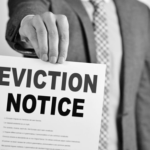Introduction
Becoming a landlord is often seen as a step towards financial independence with the promise of passive income and the luxury of sitting on a beach without a nine to five job. However, as any experienced landlord will tell you, that isn’t reality. The revolving door of renters can involve some troublesome tenants who set forth a new nightmare. One recent example is a Los Angeles homeowner who rented his mansion on AirBNB to a squatter who hasn’t left and instead claims that the homeowner owes her money. The good news is that North Dakota and Minnesota have remedies that allow for an eviction of troublesome tenants. The rights and processes in North Dakota have similarities and differences to Minnesota. Some of those differences are discussed below.
Minnesota Statutes
The eviction process in Minnesota is laid out in Chapter 504B. As is common with most laws, Minnesota has a much more complex set of requirements and regulations for evictions than North Dakota. Minnesota’s regulations also change much more frequently and had many substantial changes on January 1, 2024.
Minnesota Tenant Rights And Remedies
Minnesota’s eviction statutes are much more tenant-friendly. Within Chapter 504B, the Minnesota legislature has enacted an entire section on Tenant Remedies. One of the most common tenant remedies is often called the “Pay and Stay” provision where a tenant being evicted for non-payment of rent may stay in the unit if they pay the full amount due. A tenant can also file an escrow action when the landlord is not following the terms of the lease or is violating the landlord’s legal duties imposed by statute. If the judge rules in favor of the tenant’s escrow action, some potential outcomes include the landlord being ordered to remedy violations or potentially facing a rent abatement as well.
Minnesota Eviction Process
In Minnesota, the eviction process is started in a similar manner as North Dakota. The landlord must issue a notice to quit to the tenant. As of January 1, 2024, a landlord must provide 14 days in the notice before filing an eviction for non-payment of rent. The notice must also contain certain provisions required by statute. In addition to the notice requirements, the Minnesota legislature also changed the requirements for an eviction complaint that is filed with the court after notice is given. The new eviction complaint must contain certain provisions such as stating whether the property is affected by a housing subsidy program, including a detailed accounting if alleging nonpayment of rent, and including specific information if evicting for a breach of the lease agreement. If the notice or complaint is not written or served properly, the case could be dismissed. For these reasons, it’s important for a landlord to hire an experienced attorney.
One notable difference in Minnesota is that a judgment in an eviction hearing is solely for recovery of the property and the landlord won’t receive monetary damages for the unpaid rent or damages to the unit. If a landlord receives the judgment, the court can give the tenant up to a week to “pay and stay.” If the tenant still has not paid the rent and fees due and refuses to move, the landlord may utilize a Writ of Recovery which will direct the Sheriff to remove the tenant.
North Dakota Statutes & Tenant Remedies
North Dakota has its eviction process laid out in Chapter 47-32 of the North Dakota Century Code. Although less comprehensive and not laid out in the chapter on Evictions, tenant remedies such as termination of a lease due to domestic abuse are provided in North Dakota.
North Dakota Eviction Process
North Dakota’s eviction procedure is similar to Minnesota. With some exceptions, the notice to quit must be served on the tenant in as little as three days before the landlord can proceed with an eviction action. After the notice is served on the tenant, one of two things will usually happen (1) the tenant will move out or (2) the tenant does not move out and the landlord will be forced to initiate the eviction proceeding. Unlike Minnesota, the eviction proceeding in North Dakota allows the landlord to obtain a judgment for both an eviction as well as unpaid rent or damages. In North Dakota, if the defendant does not vacate the property, the landlord can file a Writ of Execution with the court. Once signed off on, the Writ allows the Sheriff’s department to physically remove the defendant.
Problems In Evictions
Oftentimes, the biggest confusion or problems that arise in eviction actions are the result of boilerplate lease agreements that landlords purchase from a non-lawyer or find for free on websites. These generic agreements often can have counterproductive results or lead to unwanted outcomes. Another common problem is improper service of the notice or summons. Both of these can lead to the eviction action being dismissed and the tenant continuing to live rent free or causing issues. These problems are easily mitigated by hiring an experienced attorney.
Conclusion
Compliance with and knowledge of your state’s statutes will not only ensure your lease allows you the maximum protections afforded by law but will also ensure a smooth eviction of a troublesome tenant. So, whether you need a lease to be drafted for your property or an eviction of a tenant in North Dakota and Minnesota, our team at SW&L Attorneys can help. To get in touch with our team, call 701-297-2890 or email us at: info@swlattorneys.com.
This article is for informational purposes only and is subject to our disclaimer.










